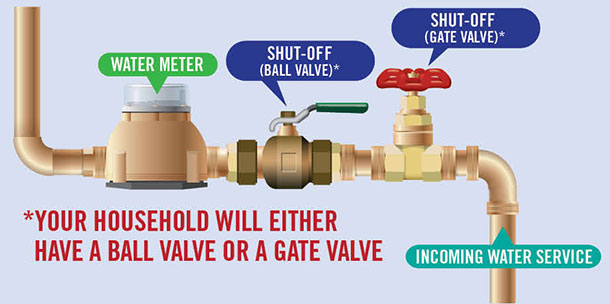
Below you'll find some helpful tips and answers to some of the most frequently asked questions we receive regarding water supply to your home.
- Water to your Property - Who's Responsible?
In general, the service (curb) box on your the front of your property is the dividing line for water coming to your property -- towards the street is the municipality's responsibility, and towards the house/building is the property owner's responsibility. The exception is the water meter, which falls to the municipality.
Middlesex Centre’s Responsibility (shown in blue)
- Service (Curb) Box: Protects the curb stop valve and should be secured and flush with the ground. It is located approximately at the property line. Never touch or cover it.
- Curb Stop Valve: Located underground, this valve controls the flow of water from the water main to your property.
- Water Mains: Underground pipes throughout the municipality that carry water to water service lines.
- Service Connection: The part of the pipe that runs from the water main to the curb stop valve in front of your property.
- Water Meter: Records the volume of water used by your property.
Property Owner's Responsibility (shown in red)- Water Service Line: Pipe that runs between the curb stop valve and your property.
- Indoor Water Shut-off Valve: Shuts off the water supply to your property.
- Indoor Plumbing: The system of water pipes, drains, fittings, valves and fixtures in your building that distribute water.
Acknowledgement: This diagram is based on work from the City of Markham.
- Understanding your System - Shut-off Valves
How Water Enters your Home
Municipally-supplied water enters your home through either a ball or gate valve - the shut-off valve - before being read by your water meter.
Make sure you know the location of your shut-off valve, and keep the area around it clear. This will help you in shutting off the water supply in your home if you need to do minor plumbing repairs.
- Detecting Leaks
If you are looking for ways to reduce your water bill, or if your bill is higher than expected, take a few minutes to check for water leaks.
Average household leaks can add up to 40 cubic meters of water wasted every year. Serious leaks can waste even more.
Common types of leaks found in the home include worn toilet flappers, dripping faucets, and other leaking valves. Repairing these leaks can save the average homeowner about 10 percent on their water bills.
Use this checklist as a starting point to look for leaks.
If you find a leak, you will want to take the necessary steps to correct the issue as soon as possible to prevent high water bills. As a homeowner, it is your responsibility to be aware of what is going on within your home. It is our responsibility as a water utility provider to bill as per the read on your water meter.
- Wastewater from your Property - Who's Responsible?
While Middlesex Centre is responsible maintaining the sewer main, property owners are responsible for the connection between the main and their building.
For more information on maintaining the sewer line on your property, including dealing with blockages and repairs, please see our Wastewater Responsibility Handout.
- Protecting your Pipes - Toilets
Don't Flush It!
Don't flush personal use wipes, paper towels, or any hygiene products down your toilet. These need to be placed in the garbage.
Anything other than No. 1, No. 2 and toilet paper can lead to sewer backups and flooded basements, may damage wastewater facilities, and pollute rivers and lakes.
To learn more, visit idontflush.ca
- Protecting your Pipes - Fats, Oil and Grease
Fats, Oil and Grease (FOG): A big problem for your household drain
When fats, oil and grease from food are poured down the drain, they are often in a warm liquid. This may not seem harmful but, as the liquid cools, the grease becomes a hardened mass.
As grease build ups over time, this mass restricts the flow of sewage – both on your property and under the roadway.
In fact, pipes blocked by grease are an increasingly common cause of sewage back-ups and septic issues in homes as well as sewer overflows. Each year, a considerable amount of time and money is spent cleaning clogged pipes throughout the municipality as a result of grease in the sanitary sewer system.
Video: Safely managing Fats, Oils and Grease
What Can You Do to Help?
- DO wipe out greasy pots, pans, and utensils with paper towel before putting them into the sink.
- DO use a strainer in the sink to catch food scraps and other solids.
- DO place grease in a cup, jar or can and store it. Once the grease solidifies place it into the garbage, or feed it to birds as suet feeders.
- DO inform friends and neighbours about the problem with fats, oil and grease in the sewer system.
- DO pour turkey and roast drippings into a container and dispose in garbage.
- DO pick-up a FOG cup!
FOG Cups - Take a Cup! Fill it Up.
Middlesex Centre has FOG Cups available free-of-charge for residents. You can pick yours up at the municipal office or the Komoka Wellness Centre.
Related Documents
Put Fats, Oils and Grease (FOG) in the Right Place
Don't Block that Line: How to prevent Clogs, Backups and Overflows

